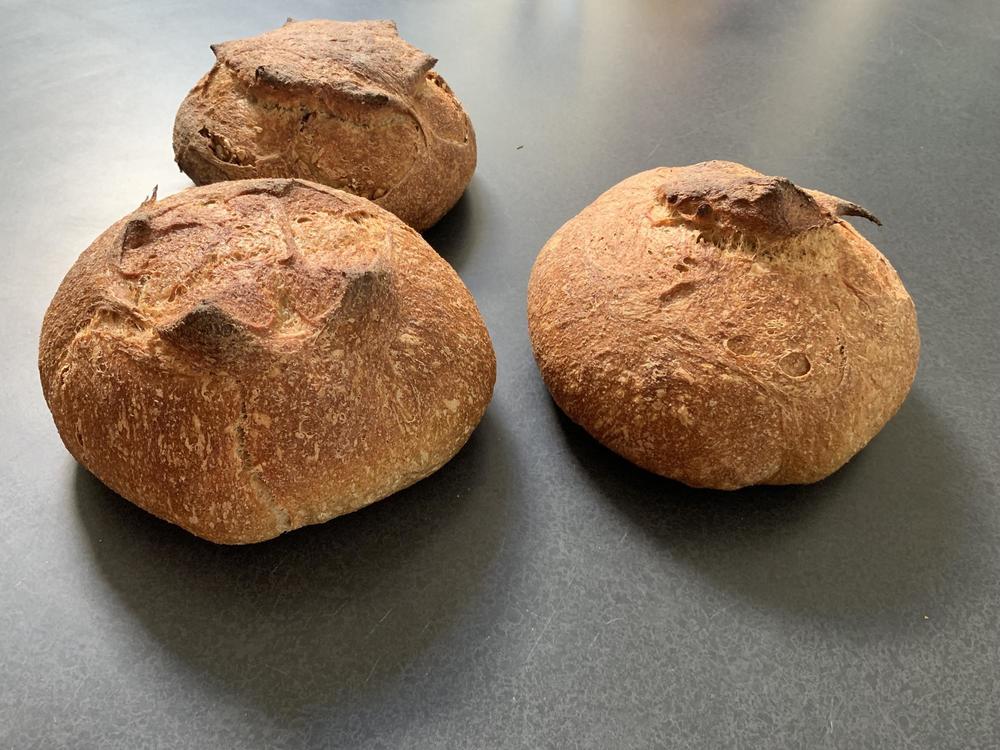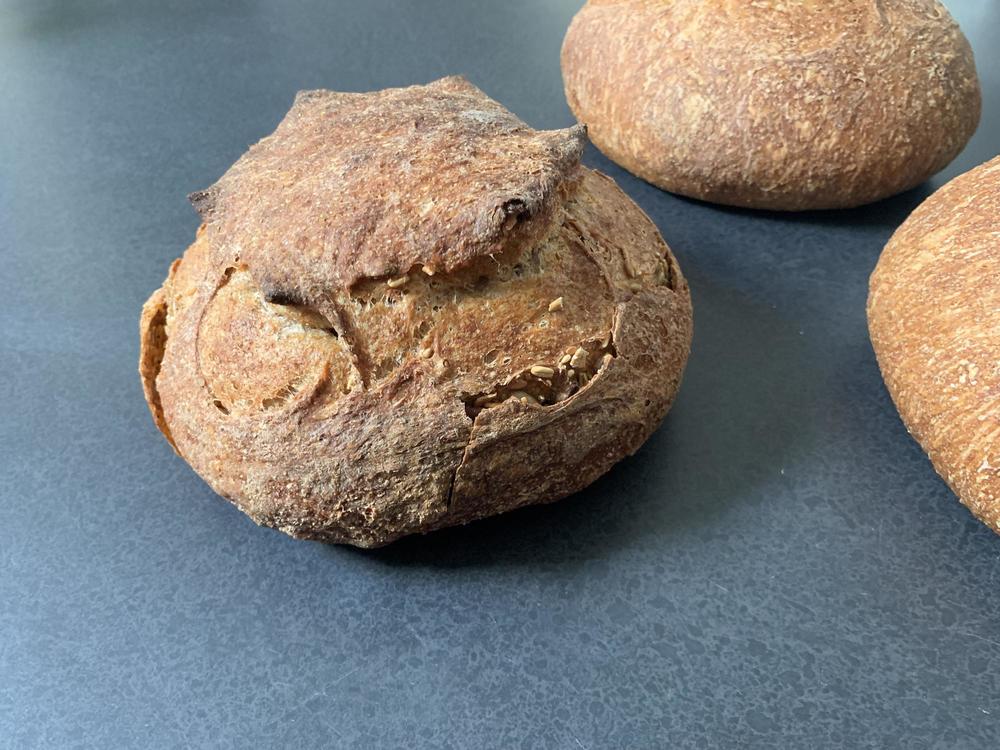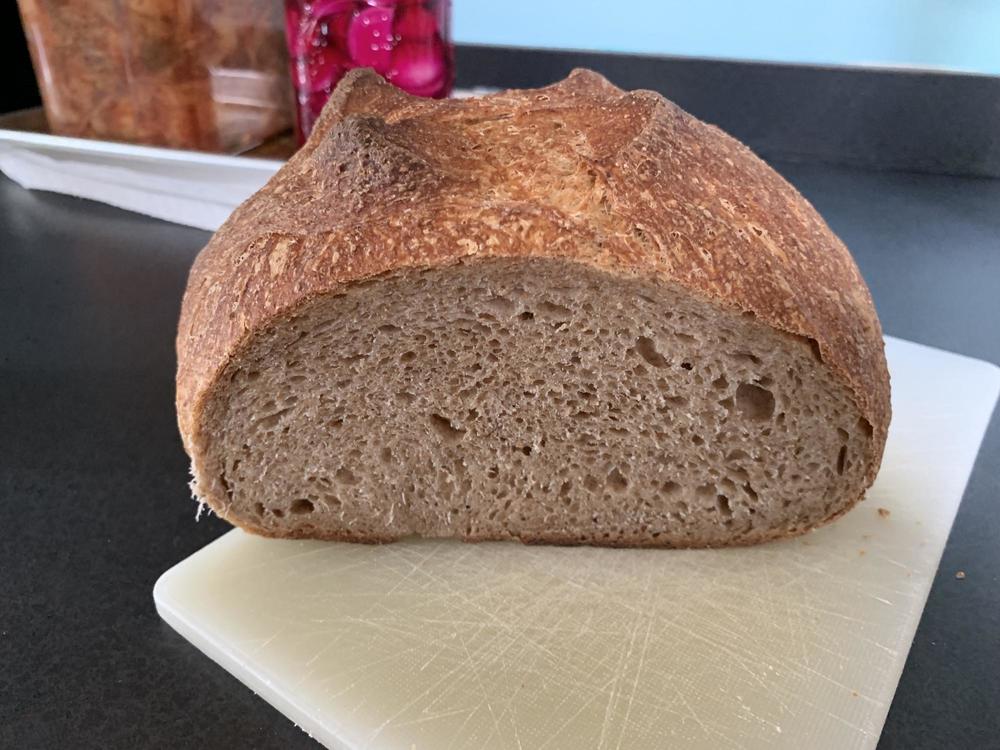
dtremit
participating member-
Posts
644 -
Joined
-
Last visited
Content Type
Profiles
Forums
Store
Help Articles
Everything posted by dtremit
-
Finally back to baking sourdough bread after a few months -- my KitchenAid finally died, and as I dithered about what to about it, I neglected my starter in the back of the fridge. These are the first loaves from my new setup -- an older Bosch Universal from eBay and a starter from the lovely Elmendorf Baking in Cambridge. These were made with what has been my standard recipe -- about half whole grain flour (~45% whole wheat, 5% rye) and half bread flour, and 68% hydration. Folded some seeds, nuts, and grains into the smaller loaf for some variety. Still would like a more open crumb, but I'm getting much better oven spring now, great flavor, and the crumb is quite pleasant. I do wish I'd left these in a bit longer to get some more color; I was afraid of burning the bottom, but I had more margin than I realized.
-
One dressing I've stumbled on for slaw is a za'atar ranch -- a classic buttermilk Ranch base, with a few tablespoons of good za'atar mixed in. It works particularly well on a slaw with a lot of scallions and some jalapeño for a bit of kick.
-
Thanks, Isabelle! I had gotten as far as figuring out that the KAF stuff was "high heat," but most dry milk seems to be sold as "instant" or "non-instant." The only stuff I can find explicitly listed as "high heat" (or low heat, for that matter!) is in 50 pound bags. I have seen people say that "non-instant" dry milk is produced via a high-heat process. I mostly use it for one specific bread, though, so I think I'm just going to try a pound of "non-instant" and see how it comes out.
-
I understand shipping is a significant cost for retailers, especially small ones -- but KAF charges a premium for nearly everything already, which makes the high shipping charges hard to stomach. For things I can't easily source elsewhere, I tend to wait for one of their free shipping specials. Currently trying to find another source for their "Bakers Special Dry Milk" -- have seen suggestions that any non-instant dry milk would be the same thing. Probably going to try some from Barry Farm (via Amazon) and see if I get the same results.
-
Matfer makes some pans with a 3" x 3.5" cross section, but the longest seems to be ~10": https://www.matferbourgeatusa.com/exopan-bread-mold-with-lid-6 https://www.matferbourgeatusa.com/exoglass-bread-mold-with-stainless-steel-lid-7
-
I didn't mean that 11.7% was a high protein flour -- just that it was higher than usual for an all purpose flour. 13% is more unusual still. Going back to your original post, you were saying people ask you whether you need to use bread flour. Obviously not -- your bread is stunning. I'm just saying someone who buys a bag of Gold Medal isn't likely to get the same results -- let alone one of the lower protein "AP" flours like White Lily.
-
Sadly Nutrition Facts labels are rounded to the nearest gram (except for some values <1g). So "4g" could be anywhere from 3.5g (11.66%) to 4.49g (14.96%). There probably is some difference between those two flours, just not a big enough one to survive the rounding process. Since no one eats flour by the tablespoon, I wish they'd just change the "serving size" to 100g and be done with it. That would reduce the margin of uncertainty a bit.
-
First -- what beautiful loaves! I think being marked as "bread flour" is a lot less reliable an indicator of protein percentage than we'd like it to be. Really wish producers would just put the percentage on the bag. I can't find the Silver Star specifically, and the 30g serving size makes it kind of imprecise, but the Rogers website claims both the AP and "bread flour" have 4g of protein per 30g serving. I assume that means they both have a minimum of 3.5g/30g = 11.66%, as anything under 3.5g/30g would be rounded down. King Arthur bread flour is 12.7%, with their AP notably high at 11.7%; plenty of KAF's bread recipes call for AP. Gold Medal AP is lower at 10.5%. An old Chowhound thread here speculates that Canadian flour is higher protein across the board. All a long-winded way of saying that your AP flour may well be higher protein than the bread flour others can find.
-
One of the things I have trouble with sometimes is figuring out if my dough is slack because it's too wet, or if it's slack because I've not built up enough structure. The former kind of dough can get great results poured into a preheated Dutch oven, whereas the latter kind isn't going to get an open crumb no matter what. But the difference isn't always obvious to me, particularly as the whole grain percentage goes up. That said, almost any slack dough will make a good cast iron skillet pizza. (Probably a decent focaccia, too, now that I think about it.)
-
Sadly not -- I go on a pilgrimage to Daiso every time I'm in California or Texas for work. I did read recently that one has opened in Flushing, Queens, so maybe there's hope for us someday. If Muji and Uniqlo thought Boston was a good market...
-
@Cyber Akuma I can't speak to longevity, but we just got this, and like it so far: https://us.toshiba-lifestyle.com/products/us/Cooking-Appliances/Microwave-Ovens/Toshiba-1.6-Cu.-Ft.-Invertech-Microwave-Oven,-Stainless-Steel.html The latest Wirecutter reviews rated Toshiba models very highly, and it seemed to be a good mix of power, features, and size for us. It's 1.6 cubic feet, but seems larger inside than the Kenmore it replaced. And it does have an inverter, 1200W, and a simple numeric keypad. My only slight irritation is that you have to hit "cook time" to enter a time directly -- but it has shortcuts for 1-6 minutes and +0:30, so I don't actually need to do that very often. I ended up getting it on sale at JCPenney (of all places!) for $145 shipped. They do have a 1.5 cu ft convection model, but I didn't consider that as my Breville already sits on top of the microwave
-
Huh. I've never seen a corner cabinet like that, @heidih! Specifically the extra bit where the toaster is. With the shelf removed, you might be able to use one of the "blind corner" solutions like @Kerry Beal posted on the "long" side, and have a skinny space for baking trays on the short side. (Assuming, of course, the door opens wide enough.)
-
Oh, definitely. Not really possible to avoid a corner cabinet in some kitchen shapes -- including mine. The solutions for "blind" corner cabinets are so superior, though, that I can't imagine specifically using an L-shaped cabinet under most circumstances. I'm lucky (in many ways) to own this place, but it's too small for us long-term; we're mostly waiting out the transit project that's hammering outside my window to wrap up before we move on. So as much as I'd like to gut the kitchen...
-
In your particular case, I wonder if something like this would be useful: Not-so-lazy Susan ? I don't need to store skillets in my corner cabinet but it seems like it'd be useful if I did. That Shelf Genie "Glide Around" looks almost ideal -- but given you can't even get a price without a "design consultation" I'm guessing it's stupid expensive. This wire equivalent is interesting, but the center drawer is only 12" wide, which is just a little too small for a lot of stuff I do store down there. And I feel like nothing would actually fit in the side baskets. Plus it's $600, versus $120 for a good lazy susan. (I can commiserate on the knees -- you can probably hear my cursing up in Canada when I drop something behind my freezer drawer, which I imagine is similar.)
-
Somehow missed your reply the first time around. Sadly the opening on mine is small enough that I think I'd end up with an 10" wide drawer out of a 30" cabinet...
-
@heidih yeah -- I understand there are probably situations where nothing else fits, but in my kitchen, there's a 30" cabinet on one side, and a 36" cabinet on the other. They could have adjusted those slightly and fit a "blind" corner cabinet with the magic pullout shelves to much better effect.
-
My door works that way too -- I just couldn't find a picture that showed the shelf configuration and the door. Of course I didn't think to post this until I got to the office... 😀 The single tier idea is appealing -- I do keep some small appliances on the bottom of the cabinet, and I'd thought I'd need to give that up for the lazy susan. How is yours mounted to the cabinet? I mean, nothing's permanent with the right power tools. I honestly am not sure if it's on shelf pins (all the shelves in the other cabinets are) or screwed in, but I wouldn't hesitate to saw it out. There is a plastic cap in the bottom of the cabinet that looks like it's designed for a lazy susan. Thanks for the additional vote of confidence. No lead on wedge shaped canisters, but I did come across wedge-shaped bins when searching for organizers.
-
I'm fortunate to have stumbled upon an apartment with a fantastic kitchen layout -- despite being compact, it's got a great modified-galley layout that's a pleasure to work in. However, the previous owner who built it stuck a pie-cut corner base cabinet in one corner, and that thing is the bane of my existence. To be clear, it's this kind of cabinet (though it's got a single two-piece door) : Like the one in the picture, it's got a L-shaped, half-depth shelf. Sadly none of the nifty organizers used for blind corner cabinets seem to exist for this style -- there's just lazy susans, which a lot of people seem to hate. And I don't even have one of those (though I think there's a mounting hole). I have bad knees, following an injury, and I can't even reach half the cabinet; I have to call my partner over if I need something that's slipped in the back. And the shelving arrangement makes it difficult to store little-used stuff; the shelf is too shallow to store big stuff, too short to store tall stuff, and even at the ends it's hard to reach. Does anyone else have a cabinet like this, and if so, have you found a good way to use it? Do you have a lazy susan you love? Is there hope for me and my cabinet? 🤣
-
There's always a bottle in my fridge -- though honestly I've never thought to mix it with anything! Putting it in a salad dressing sounds quite nice. I grew up eating fruit salads with a dressing of sour cream + brown sugar, and I imagine it would be a good sub in that. (That said, I'm one of Those People with a very high tolerance for chili heat -- the spice in sweet chili sauces doesn't even register for me. I think of it as interchangeable with sweet+sour. This sometimes becomes awkward when I prepare food I think is mild and it blows someone's head off...)
-
My favorite mixed-from-bottles cocktail sauce is Heinz "Chili Sauce" (which is basically just fancy ketchup), horseradish, and a few drops of a strong hot sauce (the TJ's habanero sauce works pretty well). I've used ketchup when I've been out of chili sauce, though. Generally I find chili sauce adds a little complexity to most ketchup hacks. Other favorite cheater sauces: Sour cream + horseradish + salt & pepper: "horseradish cream" for steaks or roast beef Hoisin + barbecue sauce (as a sandwich topping) Honey + hot sauce (for fried chicken)
-
Oddly, I noticed when watching a very old Julia Child episode the other night (French Bread, from her first color series) that she seemed to have an *electric* plastic wrap dispenser.My guess is one of these, though it was hard to see. Never imagined such a thing existed.
-
Huh. I was thinking it might have been a lower protein flour causing the issue, as compared with UK "strong" flour, but KAF bread flour is about as "strong" as you can easily get in the US.
-
What kind of flour did you use?
-
This appears to be the same unit as the Koto Smart carried by H-Mart: https://www.hmart.com/84603400967 I'm almost certain I saw a video review of it under a third brand, but I can't place it right now.
-
Thanks for the heads up! I'll look for them next year. Wouldn't have had room in the freezer this year anyway...sigh. It's...weirder than that -- they're both still under the same ownership, but have been handed off a few times. And after renaming all but a handful of Star Markets to Shaw's a while back, they reversed course and switched a bunch of Shaw's to Star. The one closest to me was built as a Shaw's, and is now a Star, but the receipts still say Shaw's several years after the name change. Puzzling. With regard to the sales -- one thing I've found is that they have (at least) two circulars some weeks, and different stores get different ones. The tall circular (in a newspaper format) tends to have better prices and is used at stores in more price sensitive areas; the tabloid format circular has higher prices and is at stores in more affluent areas. At least the last time I looked at it, the "tall" one was used at the Twin City Plaza (Camb/S'ville line) Star, the Porter Square Star, and the Waltham Shaw's; the "tabloid" one was used in the Belmont Shaw's and the Mt Auburn Star in Cambridge. Of course, this week there's only one, for Thanksgiving.








